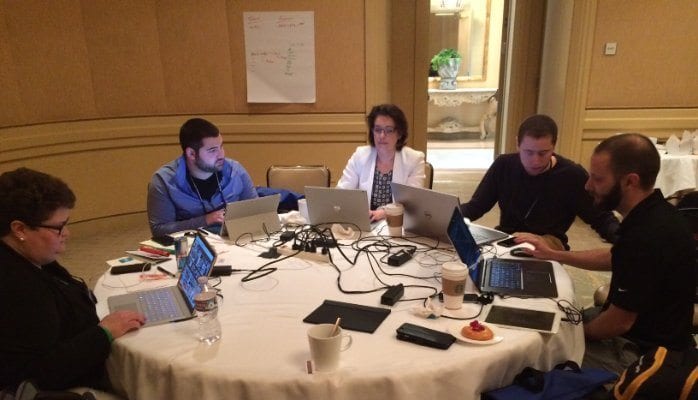
Image Source: Christy Spokely
If you read last year’s article, written by my colleague Michael, about the fun we had building a chatbot for ExtremeCRM’s Innovation Challenge, then you won’t be surprised that we decided to participate in this year’s competition as well. Hosted most recently in Newport Beach in December, ExtremeCRM is twice-a-year conference that brings together some of the world’s foremost experts in Microsoft Dynamics CRM implementation, and the Innovation Challenge allows several of us to team up, brainstorm a brand new product, and build that product from scratch. This year we decided to build an augmented reality app that integrates with CRM. Here’s how we did it:
Choosing Our Teams
The way the Innovation Challenge works is that everyone who plans to participate gathers in a large room on the first day of the conference. Everyone who has an idea for a product will write it on a piece of paper and submit it, and once the ideas have been read out everyone votes on which ideas to pursue, narrowing them down to four. Once we had the four finalists, then all the participants could join the team for the idea they found most interesting.
My colleague Michael Ochs and I represented Cobalt at the event, and we pitched an idea for an augmented reality app for which we had developed a proof of concept beforehand. While Michael and I are both developers, we were joined by two consultants and the CEO of a Microsoft implementation partner as well.
Designing a Use Case
For the Innovation Challenge, you can’t just go straight to work on the app, you have to design a use case to justify its existence. For instance, you could create an app that integrates the game Solitaire with CRM, but there’d be no practical application for such an app in the real world. This is where the help of our non-technical counterparts on the the team came in; they were more adept at client-side interactions and selling potential customers on new products.
After a lot of back-and-forth discussion, we settled on a use case in which a maintenance worker goes to repair an MRI machine. The worker can pull out a mobile device, point its camera at the MRI machine, and then the app pulls all relevant information about the machine directly from CRM — everything from when it was purchased to when it was last serviced. Once he finishes repairing the machine, he inputs this new information into the app, and then it feeds back into CRM.
Building the App
We had exactly one day (or rather, roughly eight hours) to build the app. Obviously, building out augmented reality capabilities from scratch would be an enormous task, especially in such a short time frame. Luckily, rather than reinventing the wheel, we were able to leverage third party tools to get the job done. The third party solution, called Wikitude, is built upon another platform called Xamarin, which is a C# solution that works across platform between Apple and Android devices.
Using a tablet we borrowed from a teammate, we were able to build the app so that a photo we pulled of an MRI machine from Google Image Search could be first identified and then overlaid with dummy data we had fed into the CRM. While the app did work, it was of course far from market ready. However, with hackathons, the important thing is having a proof of concept, not producing a viable product that’s ready to ship
Presenting the Idea
The presentations for the Innovation Challenge took place on the last day of the conference. When it was our time to present our app, each of us took turns either describing the use case or demonstrating the app’s abilities. As someone who isn’t use to public speaking, I can say that this was the largest audience I’ve ever spoken in front of.
[LIKE THIS ARTICLE SO FAR? THEN YOU’LL WANT TO FOLLOW US ON TWITTER TO GET THE LATEST CRM AND SALES INSIGHTS]
Once all the teams finished presenting their creations, the crowd voted for their favorite using a mobile app they’d all downloaded prior to the event. We ended up getting second place. The team that won had created a drone scheduler that integrated with CRM. While their idea was innovative, they also performed particularly well during the presentation by injecting a fair amount of humor and lightheartedness into their talks.
What I Learned from the Challenge
What I love about hackathons is that they pull you out of your comfort zone and force you to build something from nothing while working with people you’ve never met before. Even if the thing you build will never get used outside of the hackathon, the experience makes you a better developer because it removes the tunnel vision that can quell creative thinking and problem solving.
I also learned that developing a product is only half the battle; you also need to be able to sell it. One of the reasons we didn’t get first place is because our presentation relied too heavily on reciting the app’s functionality and not enough on selling it. Working as a developer, it’s easy to get bogged down in the technical details without really thinking about the end customer and what their needs are. The Innovation Challenge was a helpful reminder that simply out-innovating your competition isn’t enough to guarantee success.
Are you ready to take your business to the next level with cutting-edge CRM technology? Go here to learn more.
